Pandas to_datetime
Pandas is a powerful data manipulation library in Python that provides flexible and efficient data structures designed to work with structured (tabular, multidimensional, potentially heterogeneous) and time series data. One of the most frequently used functions in Pandas is to_datetime, which is used for converting various formats of date and time data into datetime objects. This conversion is crucial for time series analysis, time-based indexing, and various other time-related operations.
In this article, we will delve into the intricacies of the to_datetime function, providing a comprehensive overview along with detailed examples. We will cover the following topics:
- Introduction to
to_datetime - Basic Usage
- Handling Different Date Formats
- Handling Time Zones
- Working with Unix Timestamps
- Handling Missing Values
- Custom Parsing with
formatParameter - Working with Multi-column Date Data
- Combining Date and Time Columns
- Parsing Dates in DataFrames
- Common Errors and Troubleshooting
1. Introduction to to_datetime
The to_datetime function in Pandas is used to convert a column or a list-like object containing dates and times to a Pandas DatetimeIndex or Series of datetime64 objects. This conversion is fundamental for performing time series operations and leveraging the powerful time-related functionality provided by Pandas.
Example Code
import pandas as pd
# Example code to demonstrate to_datetime function
date_series = pd.Series(["2024-07-20", "2024-07-21", "2024-07-22"])
datetime_series = pd.to_datetime(date_series)
print(datetime_series)
Output:
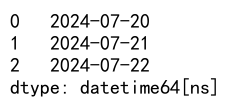
Explanation
In the example above, we start by importing the Pandas library. We then create a Pandas Series containing date strings. The to_datetime function is called on this series, converting the date strings into datetime64 objects. Finally, we print the converted datetime_series.
2. Basic Usage
The basic usage of to_datetime involves converting a single column of date strings into datetime objects. This conversion can be performed on a Pandas Series or DataFrame.
Example Code
import pandas as pd
# Basic usage of to_datetime
data = {
'date': ["2024-07-20", "2024-07-21", "2024-07-22"]
}
df = pd.DataFrame(data)
df['date'] = pd.to_datetime(df['date'])
print(df)
Output:
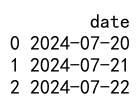
Explanation
In this example, we create a DataFrame with a single column named date containing date strings. By applying pd.to_datetime to this column, we convert the date strings into datetime64 objects. The modified DataFrame is then printed.
3. Handling Time Zones
Time zone handling is crucial for accurate time series analysis, especially when dealing with data from multiple time zones. The to_datetime function can handle time zone conversions using the utc and format parameters.
Example Code
import pandas as pd
# Handling time zones
data = {
'datetime': ["2024-07-20 12:00:00", "2024-07-21 14:00:00", "2024-07-22 16:00:00"]
}
df = pd.DataFrame(data)
df['datetime'] = pd.to_datetime(df['datetime'], utc=True)
print(df)
Output:
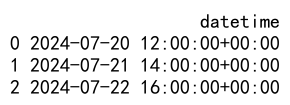
Explanation
In this example, we have a DataFrame with a datetime column containing date and time strings. By setting the utc parameter to True, we convert these strings into UTC datetime objects.
4. Working with Unix Timestamps
Unix timestamps are a common way to represent dates and times as the number of seconds since January 1, 1970 (the Unix epoch). The to_datetime function can easily convert Unix timestamps to datetime objects.
Example Code
import pandas as pd
# Working with Unix timestamps
data = {
'timestamp': [1626787200, 1626873600, 1626960000]
}
df = pd.DataFrame(data)
df['timestamp'] = pd.to_datetime(df['timestamp'], unit='s')
print(df)
Output:
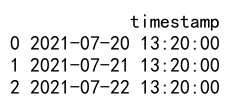
Explanation
In this example, the timestamp column contains Unix timestamps. By setting the unit parameter to 's', we convert these timestamps to datetime objects.
5. Handling Missing Values
When dealing with real-world data, missing values are inevitable. The to_datetime function can handle missing values gracefully.
Example Code
import pandas as pd
# Handling missing values
data = {
'date': ["2024-07-20", None, "2024-07-22"]
}
df = pd.DataFrame(data)
df['date'] = pd.to_datetime(df['date'])
print(df)
Output:
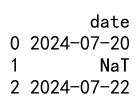
Explanation
In this example, the date column contains a missing value (None). The to_datetime function converts the valid date strings to datetime objects and leaves the missing value as NaT (Not a Time).
6. Custom Parsing with format Parameter
For cases where the date format is known and consistent, the format parameter can be used to specify the exact format, which can improve performance.
Example Code
import pandas as pd
# Custom parsing with format parameter
data = {
'date': ["2024/07/20", "2024/07/21", "2024/07/22"]
}
df = pd.DataFrame(data)
df['date'] = pd.to_datetime(df['date'], format="%Y/%m/%d")
print(df)
Output:
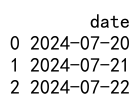
Explanation
In this example, the date column contains date strings in the format YYYY/MM/DD. By specifying this format using the format parameter, we ensure accurate and efficient conversion to datetime objects.
7. Working with Multi-column Date Data
Sometimes date and time information is split across multiple columns. The to_datetime function can combine these columns into a single datetime object.
Example Code
import pandas as pd
# Working with multi-column date data
data = {
'year': [2024, 2024, 2024],
'month': [7, 7, 7],
'day': [20, 21, 22]
}
df = pd.DataFrame(data)
df['date'] = pd.to_datetime(df[['year', 'month', 'day']])
print(df)
Output:

Explanation
In this example, the date information is split into year, month, and day columns. The to_datetime function is used to combine these columns into a single date column containing datetime objects.
8. Combining Date and Time Columns
In many datasets, date and time information is stored in separate columns. The to_datetime function can combine these columns into a single datetime column.
Example Code
import pandas as pd
# Combining date and time columns
data = {
'date': ["2024-07-20", "2024-07-21", "2024-07-22"],
'time': ["12:00:00", "14:00:00", "16:00:00"]
}
df = pd.DataFrame(data)
df['datetime'] = pd.to_datetime(df['date'] + ' ' + df['time'])
print(df)
Output:

Explanation
In this example, the date and time columns are combined into a single datetime column by concatenating the strings and then using to_datetime to convert them into datetime objects.
9. Common Errors and Troubleshooting
Converting dates to datetime objects can sometimes lead to errors due to format inconsistencies or invalid date strings. Understanding common errors and how to troubleshoot them is essential.
Example Code
import pandas as pd
# Common errors and troubleshooting
data = {
'date': ["2024-07-20", "invalid_date", "2024-07-22"]
}
df = pd.DataFrame(data)
try:
df['date'] = pd.to_datetime(df['date'])
except Exception as e:
print(f"Error: {e}")
Output:

Explanation
In this example, the date column contains an invalid date string. The to_datetime function raises an error when it encounters this invalid string. By using a try-except block, we can catch and handle this error, allowing the program to continue running.
Pandas to_datetime Conclusion
The to_datetime function in Pandas is an incredibly versatile tool for working with date and time data. It provides a wide range of options to handle various formats, time zones, Unix timestamps, and missing values. By understanding its capabilities and limitations, you can efficiently perform time series analysis and other time-related operations in your data analysis workflow. The detailed examples provided in this article should give you a solid foundation for mastering the to_datetime function.
 Pandas Dataframe
Pandas Dataframe